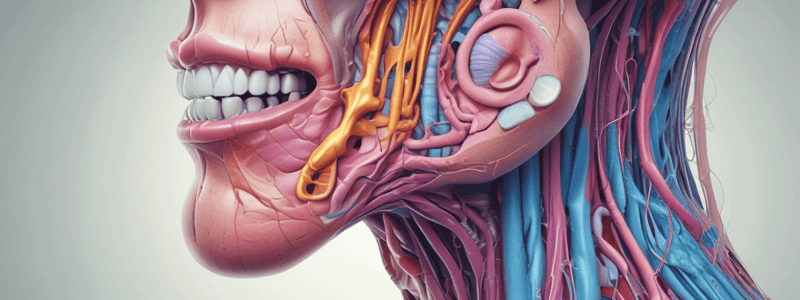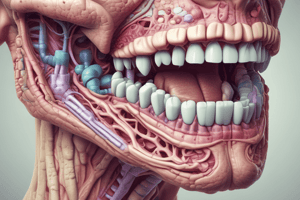Podcast
Questions and Answers
What type of tissue supports the epithelial component in salivary glands?
What type of tissue supports the epithelial component in salivary glands?
- Nervous tissue
- Epithelial tissue
- Muscle tissue
- Connective tissue (correct)
What is the function of serous cells in salivary glands?
What is the function of serous cells in salivary glands?
- To produce thin, watery and proteinaceous secretion (correct)
- To regulate blood pressure
- To produce mucous
- To produce hormones
What is the shape of serous cells under light microscopy?
What is the shape of serous cells under light microscopy?
- Spherical
- Fibroblast
- Pyramidal (correct)
- Cuboidal
What is the location of the nucleus in serous cells?
What is the location of the nucleus in serous cells?
What is the function of the duct system in salivary glands?
What is the function of the duct system in salivary glands?
What is the characteristic of the cytoplasm of serous cells under light microscopy?
What is the characteristic of the cytoplasm of serous cells under light microscopy?
What is the characteristic of the Golgi complex in serous cells under electron microscopy?
What is the characteristic of the Golgi complex in serous cells under electron microscopy?
What is the purpose of desmosomes in myoepithelial cells?
What is the purpose of desmosomes in myoepithelial cells?
What is the term given to myoepithelial cells due to their unique shape?
What is the term given to myoepithelial cells due to their unique shape?
What is the function of the ductal system?
What is the function of the ductal system?
What type of cells line the intercalated ducts?
What type of cells line the intercalated ducts?
What is characteristic of striated ducts under electron microscopy?
What is characteristic of striated ducts under electron microscopy?
What is the shape of the nucleus in intercalated ducts?
What is the shape of the nucleus in intercalated ducts?
What is found in the basal cytoplasm of intercalated duct cells?
What is found in the basal cytoplasm of intercalated duct cells?
What is the function of the striated duct in terms of secretion and reabsorption?
What is the function of the striated duct in terms of secretion and reabsorption?
Where are the terminal excretory ducts located?
Where are the terminal excretory ducts located?
What type of cells are found in the terminal excretory ducts?
What type of cells are found in the terminal excretory ducts?
What is the function of the Von Ebner gland?
What is the function of the Von Ebner gland?
Where is the Von Ebner gland located?
Where is the Von Ebner gland located?
What type of epithelium is found in the terminal excretory ducts and excretory ducts?
What type of epithelium is found in the terminal excretory ducts and excretory ducts?
What is the characteristic of the epithelial cells in the striated duct?
What is the characteristic of the epithelial cells in the striated duct?
What is the primary function of amylase in saliva?
What is the primary function of amylase in saliva?
What is the percentage of water in saliva?
What is the percentage of water in saliva?
Which gland secretes the most saliva?
Which gland secretes the most saliva?
What is the role of lingual lipase in saliva?
What is the role of lingual lipase in saliva?
What is the function of saliva in temperature regulation?
What is the function of saliva in temperature regulation?
What is the purpose of the duct in Weber glands?
What is the purpose of the duct in Weber glands?
What is the main component of inorganic substances in saliva?
What is the main component of inorganic substances in saliva?
What is the role of saliva in oral tissue maintenance?
What is the role of saliva in oral tissue maintenance?
Which gland is associated with lingual tonsils?
Which gland is associated with lingual tonsils?
What is the role of saliva in digestion?
What is the role of saliva in digestion?
What is the characteristic shape of mucous cells under a light microscope?
What is the characteristic shape of mucous cells under a light microscope?
What is the characteristic feature of the nucleus in mucous cells?
What is the characteristic feature of the nucleus in mucous cells?
What is the purpose of Mucicarmine stain?
What is the purpose of Mucicarmine stain?
What is the characteristic feature of secretory granules in mucous cells?
What is the characteristic feature of secretory granules in mucous cells?
Where are myoepithelial cells located?
Where are myoepithelial cells located?
What is the characteristic shape of myoepithelial cells?
What is the characteristic shape of myoepithelial cells?
What is the function of myoepithelial cells?
What is the function of myoepithelial cells?
Study Notes
Salivary Glands
- Composed of epithelial (parenchyma) and connective tissue components
Secretory Units
- Consist of serous, mucous, and myoepithelial cells
- Serous cells:
- Secretion: thin, watery, and proteinaceous
- Shape: pyramidal
- Nucleus: spherical and basally located
- Cytoplasm: intensely stained with H&E
- Contain numerous secretory granules
- Mucous cells:
- Shape: triangular or pyramidal
- Nucleus: flattened and basally placed
- Cytoplasm: washed-out in routine H&E sections
- Contain numerous granules containing mucins
- Myoepithelial cells:
- Contractile cells associated with secretory end piece and intercalated duct
- Derived from epithelium
- Stellate shaped or spiderlike shape
- Scanty perinuclear cytoplasm
Ductal System
- Consists of intercalated ducts, striated ducts, and terminal excretory ducts
- Intercalated ducts:
- Lined by a single layer of low cuboidal cells
- Contain a few secretory granules
- Round or oval centrally placed nucleus
- Small amount of RER in basal cytoplasm
- Striated ducts:
- Lined by columnar cells
- Central placed nucleus
- Pale, acidophilic cytoplasm
- Electron microscopy: prominent striations at basal part of cells
- Numerous elongated mitochondria in narrow cytoplasmic region
- Terminal excretory ducts:
- Located in connective tissue septa
- Larger in diameter than striated ducts
- Pseudostratified tall columnar cells admixed with small basal cells and goblet cells
Lingual Glands
- Anterior lingual glands: Blandin-Nuhn
- Posterior lingual glands: Von Ebner gland and Weber gland
- Von Ebner gland:
- Location: between muscle fibers, below circumvallate and foliate papillae
- Function: washing out the trough of papillae and readying taste receptors for a new taste stimulus
- Weber glands:
- Location: posterior one-third of tongue, post to sulcus terminalis in association with lingual tonsils
- Duct: dorsal surface of tongue through the lingual crypts
Composition of Saliva
- 99% water and 1% organic and inorganic substances
- Organic substances: proteins, enzymes, mucins, and antibacterial substances
- Inorganic substances: sodium, chloride, bicarbonate, and small amounts of calcium, magnesium, phosphate, iodine, thiocyanate, and fluoride
Functions of Saliva
- Digestion of food
- Moistening and lubrication of oral tissues
- Role in speech
- Temperature regulation in animals
Studying That Suits You
Use AI to generate personalized quizzes and flashcards to suit your learning preferences.
Description
This quiz covers the structure and function of salivary glands, including the epithelial and connective tissue components, secretory units, and duct system. Learn about serous cells, mucous cells, and myoepithelial cells, and how they contribute to salivary gland function.




